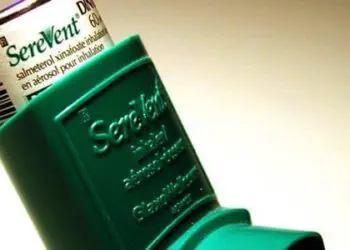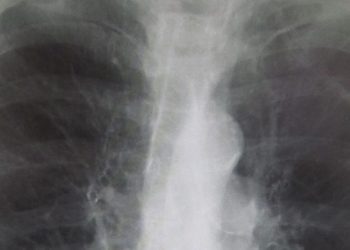Tiotropium bromide safe and effective in treating early childhood wheezing
1. In a randomized controlled trial, tiotropium bromide was an effective stand-alone treatment for intermittent wheezing in children under the age of 3 and was associated with greater proportion of days free of wheezing when compared inhaled fluticasone and as-needed albuterol sulfate.
2. Tiotropium bromide was associated with less medication side effects that lead to discontinuation of treatment compared to as-needed albuterol sulfate treatment.
Evidence Rating Level: 1 (Excellent)
Study Rundown: Episodic wheezing commonly occurs in children during the first 3 years of life during viral illnesses. Although episodic wheezing can resemble asthma exacerbations, the underlying pathophysiology varies significantly, and many asthma medications are unlikely to address mucus hypersecretion that is central to episodic wheezing in young children. One asthma medication, tiotropium bromide, is a long-acting anti-muscarinic agent that decreases mucus production, but is not well studied as an independent treatment of episodic wheezing. To address this shortcoming, this study aimed to assess the efficacy of intermittent tiotropium bromide in the treatment of episodic wheezing in infants and toddlers, using a randomized open-label controlled parallel group trial at 4 hospitals in Finland. The study population included 80 children divided into 3 groups treated with (1) intermittent tiotropium bromide with as needed albuterol sulfate, (2) intermittent fluticasone propionate with as needed albuterol sulfate, or with (3) as needed albuterol sulfate alone. Subjects were followed for 48 weeks. The proportion of episode free-days without wheezing was higher in those receiving intermittent tiotropium bromide than those receiving the other treatments. In addition, the proportions of patients who discontinued the treatment because of respiratory symptoms was the lowest in those treated with intermittent tiotropium bromide. In general, this study provides evidence that intermittent tiotropium bromide can be used as an independent treatment of intermittent wheezing, which was previously used solely as an add on therapy. The trial is limited by its small sample size (n=80) and is likely underpowered to detect rare adverse events. Further studies with a double-blinded design and a greater sample size are required to further validate these findings prior to practice implementation.
Click here to read the article in PEDIATRICS
Relevant Reading: Safety and efficacy of tiotropium in children aged 1-5 years with persistent asthmatic symptoms: a randomised, double-blind, placebo-controlled trial
In Depth [Randomized Control Trial]: This study enrolled children aged 6 to 35 months who were born gestational age of 36 weeks of greater with 2-4 confirmed episodes of wheeze or shortness of breath without another underlying respiratory condition that could explain the condition. Of 80 participants enrolled, they were divided into 3 groups with (1) 27 patients assigned to tiotropium bromide (5 ug daily) and daily as needed albuterol sulfate and intermittent, (2) 25 patients assigned to intermittent fluticasone propionate (125 ug twice daily) and as needed albuterol sulfate, and (3) 28 patients assigned to as needed albuterol sulfate alone. The primary endpoint was proportion of wheeze-free days, which differed significantly between the intermittent tiotropium group (median 97% [interquartile range (IQR) 93% to 99%]) and other treatment groups such as the fluticasone group (median 87% [IQR 78% to 93%], p=0.002) or the albuterol alone group (median 88% [IQR 79% to 95%], p=0.003), when adjusting for allergic sensitization. As a secondary endpoint, albuterol sulfate as needed alone had a higher proportion of patients who discontinued treatment because of troublesome respiratory symptoms compared to intermittent tiotropium bromide (hazard ratio (HR) 0.26, 95% CI 0.13-0.43, p=0.004), but not compared to intermittent fluticasone propionate treatment.
Image: PD
©2022 2 Minute Medicine, Inc. All rights reserved. No works may be reproduced without expressed written consent from 2 Minute Medicine, Inc. Inquire about licensing here. No article should be construed as medical advice and is not intended as such by the authors or by 2 Minute Medicine, Inc.






![The ABCD2 score: Risk of stroke after Transient Ischemic Attack (TIA) [Classics Series]](https://www.2minutemedicine.com/wp-content/uploads/2013/05/web-cover-classics-with-logo-medicine-BW-small-jpg-75x75.jpg)